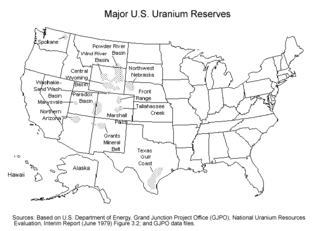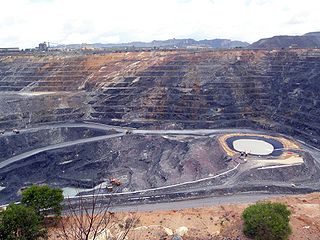
Mining is the extraction of valuable geological materials and minerals from the surface of the Earth. Mining is required to obtain most materials that cannot be grown through agricultural processes, or feasibly created artificially in a laboratory or factory. Ores recovered by mining include metals, coal, oil shale, gemstones, limestone, chalk, dimension stone, rock salt, potash, gravel, and clay. The ore must be a rock or mineral that contains valuable constituent, can be extracted or mined and sold for profit. Mining in a wider sense includes extraction of any non-renewable resource such as petroleum, natural gas, or even water.

The Australian Conservation Foundation (ACF) is Australia's national environmental organisation, launched in 1965 in response to a proposal by the World Wide Fund for Nature for a more co-ordinated approach to sustainability.

Rum Jungle or Unrungkoolpum is a locality in the Northern Territory of Australia located about 105 kilometres south of Darwin on the East Branch of the Finniss River and it shares a boundary with Litchfield National Park. It is 10 kilometres west of Batchelor.

Uranium mining is the process of extraction of uranium ore from the ground. Over 50,000 tons of uranium were produced in 2019. Kazakhstan, Canada, and Australia were the top three uranium producers, respectively, and together account for 68% of world production. Other countries producing more than 1,000 tons per year included Namibia, Niger, Russia, Uzbekistan, the United States, and China. Nearly all of the world's mined uranium is used to power nuclear power plants. Historically uranium was also used in applications such as uranium glass or ferrouranium but those applications have declined due to the radioactivity and toxicity of uranium and are nowadays mostly supplied with a plentiful cheap supply of depleted uranium which is also used in uranium ammunition. In addition to being cheaper, depleted uranium is also less radioactive due to a lower content of short-lived 234
U and 235
U than natural uranium.

National Atomic Company Kazatomprom Joint Stock Company (Kazatomprom) (Kazakh: Қазатомөнеркәсіп, romanized: Qazatomónerkásip) is the world’s largest producer and seller of natural uranium, providing over 40% of global primary uranium supply in 2019 from its operations in Kazakhstan. Kazatomprom's uranium is used for the generation of nuclear power around the world.
Paladin Energy Ltd is a Western Australian based uranium production company.

Uranium mining in the United States produced 224,331 pounds (101.8 tonnes) of U3O8 in 2023, 15% of the 2018 production of 1,447,945 pounds (656.8 tonnes) of U3O8. The 2023 production represents 0.4% of the uranium fuel requirements of the US's nuclear power reactors for the year. Production came from five in-situ leaching plants, four in Wyoming (Nichols Ranch ISR Project, Lance Project, Lost Creek Project, and Smith Ranch-Highland Operation) and one in Nebraska (Crowe Butte Operation); and from the White Mesa conventional mill in Utah.

Nuclear weapons testing, uranium mining and export, and nuclear power have often been the subject of public debate in Australia, and the anti-nuclear movement in Australia has a long history. Its origins date back to the 1972–1973 debate over French nuclear testing in the Pacific and the 1976–1977 debate about uranium mining in Australia.

Mining is the biggest contributor to Namibia's economy in terms of revenue. It accounts for 25% of the country's income. Its contribution to the gross domestic product is also very important and makes it one of the largest economic sectors of the country. Namibia produces diamonds, uranium, copper, magnesium, zinc, silver, gold, lead, semi-precious stones and industrial minerals. The majority of revenue comes from diamond mining. In 2014, Namibia was the fourth-largest exporter of non-fuel minerals in Africa.

Radioactive ores were first extracted in South Australia at Radium Hill in 1906 and Mount Painter in 1911. 2,000 tons of ore were treated to recover radium for medical use. Several hundred kilograms of uranium were also produced for use in ceramic glazes.
Four Mile is Australia's fifth uranium mine. It is sited in the Frome Basin in far north of the state of South Australia, around 600 kilometres (370 mi) north of the state capital, Adelaide. It is 10 kilometres (6 mi) from the existing Beverley uranium mine, where its uranium oxide product is produced. Construction of the mine commenced in late 2013 and the mine was officially opened in June 2014.
The Yeelirrie uranium project is a uranium deposit located approximately 70 km southwest of Wiluna, in the Mid West region of Western Australia. The name Yeelirrie is taken from the local sheep station.
Yeelirrie is an East Murchison pastoral lease or sheep station on state Crown land, located approximately 80 kilometres (50 mi) south west of Wiluna, in the Mid West region of Western Australia. The nearest population centre to Yeelirrie homestead is Mount Keith Mine village, 45 kilometres (28 mi) to the east. The regional centre is Meekatharra, located 180 kilometres (112 mi) to the west.
The Wiluna uranium mine is a proposed uranium mine in Western Australia. The mine project, owned by Toro Energy Ltd, is located 30 kilometres (19 mi) south of the mining town of Wiluna. The original proposal was to establish open cut mines at Lake Way and Centipede deposits. In 2013, the Wiluna project became the first uranium mine to receive all necessary approvals in the state of Western Australia since the ban on uranium mining was repealed there in 2008. Federal environmental approval for the mine's development was granted under the EPBC Act in April 2013.

Namibia has one of the richest uranium mineral reserves in the world. There are currently two large operating mines in the Erongo Region and various exploration projects planned to advance to production in the next few years.
The world's largest producer of uranium is Kazakhstan, which in 2019 produced 43% of the world's mining output. Canada was the next largest producer with a 13% share, followed by Australia with 12%. Uranium has been mined in every continent except Antarctica.
Western Australia has considerable resources of uranium, but to date there has been no commercial mining in the state.

The Olympic Dam mine is a large poly-metallic underground mine located in South Australia, 550 km (340 mi) NNW of Adelaide. It is the fourth largest copper deposit and the largest known single deposit of uranium in the world. Copper is the largest contributor to total revenue, accounting for approximately 70% of the mine's revenue, with the remaining 25% from uranium, and around 5% from silver and gold. BHP has owned and operated the mine since 2005. The mine was previously owned by Western Mining Corporation. Since the 1970s environmentalists, traditional owners and others have campaigned against the mine, largely on the basis of its contribution to the nuclear cycle and its use of underground water.

The Husab Mine, operated under the Husab Uranium Project, is a uranium mine near the town of Swakopmund in the Erongo region of western-central Namibia. The mine is located approximately 5 kilometres (3.1 mi) south of the larger Rössing uranium mine and 45 kilometres (28 mi) from Walvis Bay. Swakop Uranium believes the Husab Mine has the potential to become the second largest uranium mine in the world after the McArthur River uranium mine in northern Saskatchewan, Canada and the largest open-pit mine on the African continent. Mine construction started in February 2013. The Husab Mine started production towards the end of 2016 after completion of the sulfuric acid leaching plant.

Uranium mining around Bancroft, Ontario, was conducted at four sites, beginning in the early 1950s and concluding by 1982. Bancroft was one of two major uranium-producing areas in Ontario, and one of seven in Canada, all located along the edge of the Canadian Shield. In the context of mining, the "Bancroft area" includes Haliburton, Hastings, and Renfrew counties, and all areas between Minden and Lake Clear. Activity in the mid-1950s was described by engineer A. S. Bayne in a 1977 report as the "greatest uranium prospecting rush in the world".













